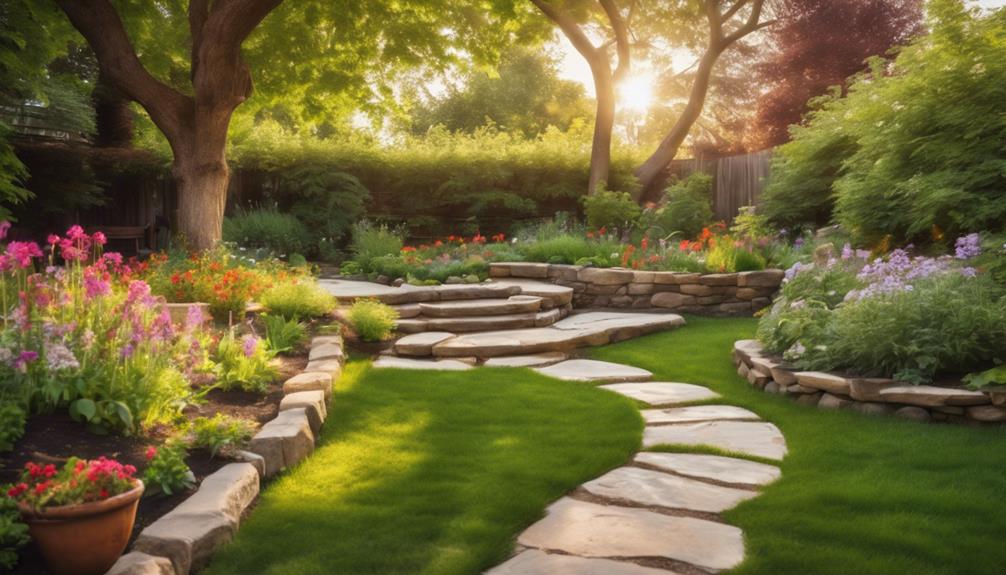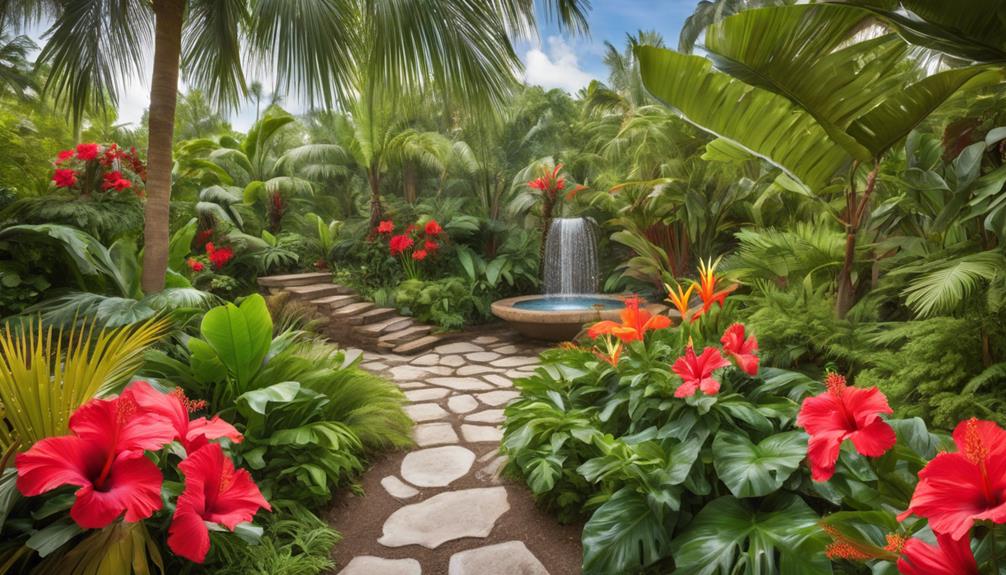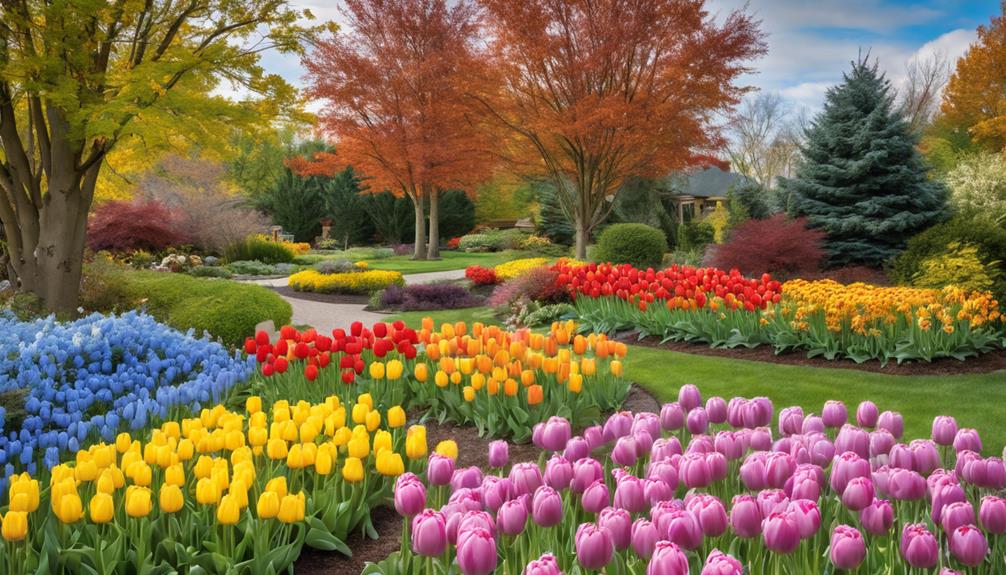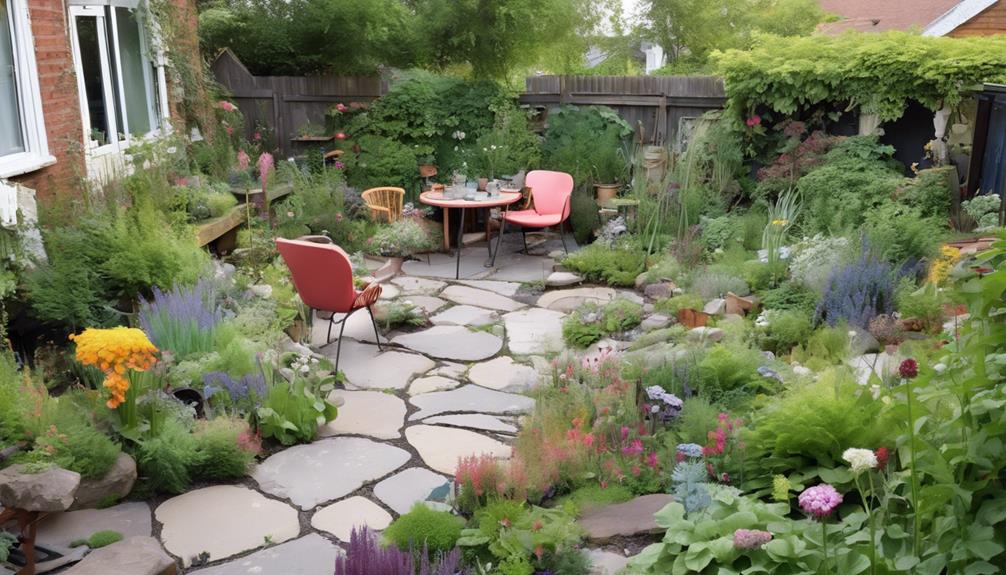
Why Invest in Garden Maintenance for Commercial Properties?
23 February 2025What Is Pressure Washing’s Effect on Garden Health?
23 February 2025This beginner's guide to simple garden design projects provides fundamental insights for creating functional and appealing outdoor spaces.
Start by evaluating your available space and sunlight exposure. Use high-quality tools for precise planting and maintenance. Incorporate plants that complement one another while considering their growth patterns.
A well-structured design blueprint is critical for balancing aesthetics and practicality. Moreover, implementing seasonal planting and efficient pest management improves the garden's vitality.
With these foundational strategies, your garden can flourish beautifully. Investigate further to uncover additional tips and techniques for transforming your outdoor space into a thriving haven.
Garden Design Project Essentials
Effective garden design begins with understanding the essential tools required for the project, as these will significantly influence your workflow and outcomes.
Additionally, careful planning of your space is crucial, enabling you to visualise your design and make informed decisions about plant placement and layout.
Together, these elements form the foundation of a successful garden design project.
Essential Tools Overview
A successful garden design project relies on a selection of essential tools that facilitate both creativity and practicality. Key tools include high-quality hand tools such as trowels, secateurs, and rakes, which enable precise planting and maintenance.
A reliable measuring tape guarantees accurate dimensions for layout and spacing, while a spirit level helps maintain even surfaces and structures. Garden design software or sketching tools can assist in visualising concepts, allowing for refined planning.
Moreover, a sturdy wheelbarrow streamlines the transportation of materials. Investing in quality tools not only improves efficiency but also fosters a deeper connection with the gardening process.
Mastery of these tools empowers gardeners to execute their vision with confidence and skill, ultimately leading to successful garden design outcomes.
Planning Your Space
Understanding the layout of your garden is fundamental to achieving a cohesive design. Begin by evaluating the available space, noting its dimensions, sunlight exposure, and existing features.
Create a scaled drawing to visualise your design, incorporating zones for planting, pathways, and seating areas. Consider the principles of balance and proportion to ensure harmony among elements.
In addition, factor in the growth patterns and mature sizes of plants to prevent overcrowding. Utilise vertical space effectively with trellises or raised beds, enhancing both aesthetics and functionality.
Ultimately, establish a workflow for installation, prioritising tasks and materials to streamline the project. By meticulously planning your space, you lay the groundwork for a flourishing garden that reflects your vision and meets your needs.
Plant Selection Criteria
Effective plant selection is essential for a successful garden design, as it hinges on understanding specific criteria.
Key factors such as soil type and quality, sunlight exposure requirements, and plant compatibility and growth rates should be thoroughly evaluated.
Soil Type and Quality
Evaluating soil type and quality is essential for successful garden design, as these factors directly influence plant health and growth.
Understanding the characteristics of your soil will enable you to select the most suitable plants for your garden.
Consider the following aspects:
- Soil Texture: Determine whether your soil is sandy, clay, or loamy, as this affects drainage and nutrient retention.
- pH Level: Test soil acidity or alkalinity; most plants thrive in a neutral to slightly acidic environment.
- Nutrient Content: Assess the presence of crucial nutrients such as nitrogen, phosphorus, and potassium, which are critical for plant vigour.
Sunlight Exposure Requirements
When planning a garden, sunlight exposure is a critical factor that greatly influences plant selection and overall design.
Understanding the light requirements of various plants is vital for fostering a thriving garden ecosystem. Here are three key sunlight exposure categories to take into account:
- Full Sun: Requires at least 6-8 hours of direct sunlight daily; ideal for heat-loving plants such as tomatoes and sunflowers.
- Partial Shade: Thrives with 3-6 hours of sunlight; suitable for plants like ferns and hostas that prefer dappled light.
- Full Shade: Needs less than 3 hours of direct sunlight; perfect for shade-tolerant plants such as astilbe and cardinal flower.
Plant Compatibility and Growth Rates
Understanding sunlight exposure is just the beginning of creating a successful garden; the next step involves considering plant compatibility and growth rates.
Selecting plants that thrive together can improve aesthetic appeal and promote healthier growth. Consider the following criteria:
- Companion Planting: Certain plants naturally repel pests or enhance nutrient uptake when grown together.
- Growth Rates: Planting fast-growing species alongside slower ones can optimise space and visual dynamics.
- Water and Nutrient Needs: Confirm that plants with similar requirements are grouped together to facilitate efficient care.
Create a Design Blueprint
Creating a design blueprint is vital for transforming your garden vision into reality.
Begin by defining the purpose of your garden, as this will guide your decisions on layout, plant selection, and features.
Additionally, consider incorporating mulch application techniques and vertical gardening strategies to enhance both aesthetics and functionality.
Define Your Garden's Purpose
Defining your garden's purpose is a fundamental initial step in the design process, as it sets the foundation for a cohesive and functional outdoor space.
A clear vision enables you to make informed decisions about plant selection, layout, and features.
Consider these critical aspects when determining your garden's purpose:
- Functionality: Will your garden serve as a space for relaxation, entertainment, or growing vegetables?
- Aesthetics: What visual elements do you wish to incorporate to create an inviting atmosphere?
- Maintenance: How much time are you willing to invest in upkeep, and how will this influence your plant choices?
Mulch Application Techniques
Once the purpose of your garden has been established, the next step in the design process involves detailing the practical aspects of maintenance, including effective mulch application techniques.
Properly applied mulch not only enhances aesthetic appeal but also promotes healthy plant growth. Consider the following techniques:
- Layering: Apply a 5-10 cm layer of organic mulch, such as wood chips or shredded bark, around plants. This conserves moisture and suppresses weeds.
- Edge Definition: Create clear boundaries using edging materials to maintain mulch integrity and prevent it from spreading into pathways.
- Seasonal Renewal: Regularly replenish mulch to maintain its effectiveness, as organic materials decompose over time and lose their benefits.
Mastering these techniques will significantly improve your garden's sustainability and visual charm.
Vertical Gardening Strategies
A well-thought-out design blueprint is essential for successfully implementing vertical gardening strategies.
To achieve mastery in this innovative gardening approach, consider the following elements:
- Site Selection: Evaluate sunlight, wind exposure, and accessibility to ensure optimal plant growth and maintenance.
- Structural Support: Choose materials such as trellises, wall planters, or repurposed pallets that can bear the weight of the plants and soil.
- Plant Selection: Opt for species that thrive in vertical environments, including climbing vines, herbs, and succulents, to enhance both aesthetic appeal and functionality.
Enhanced Property Value
Investing in thoughtful garden design can significantly enhance property value, transforming outdoor spaces into attractive extensions of the home. A well-designed garden improves curb appeal and creates inviting environments for potential buyers.
| Design Element | Impact on Property Value |
|---|---|
| Native Plant Landscaping | Reduces maintenance costs and attracts local wildlife |
| Hardscaping Features | Provides functional outdoor spaces, increasing usability |
| Outdoor Lighting | Enhances safety and aesthetics, creating a welcoming ambiance |
| Water Features | Adds tranquility and luxury, appealing to buyers seeking relaxation |
| Garden Structures | Introduces unique design elements that add character and charm |
Incorporating these elements into your garden design not only boosts aesthetic appeal but also signifies a thoughtful investment, ultimately leading to increased property value.
Seasonal Planting Strategies
Seasonal planting strategies are essential for cultivating a vibrant and flourishing garden throughout the year.
Key techniques include companion planting, which enhances plant health and productivity, as well as implementing seasonal colour schemes to ensure visual appeal in every season.
Furthermore, understanding the timing and methods for fertilisation can significantly influence plant growth and the overall success of the garden.
Companion Planting Techniques
While many gardeners focus solely on individual plant care, understanding companion planting techniques can greatly improve the health and productivity of your garden.
By strategically pairing plants, you can create a harmonious ecosystem that boosts growth and minimises pests.
Consider these crucial companion planting strategies:
- Mutual Support: Pair plants like tomatoes with basil; the latter repels pests and enhances flavour.
- Nutrient Sharing: Use legumes, such as beans, alongside corn to enrich the soil with nitrogen, benefiting both crops.
- Pest Control: Marigolds planted near vegetables can deter harmful insects, leading to healthier plants.
Implementing these techniques requires careful planning, but the rewards are substantial, creating a resilient and thriving garden environment.
Seasonal Color Schemes
Creating a visually appealing garden involves more than merely selecting individual plants; it requires a thoughtful approach to colour schemes throughout the seasons.
Seasonal colour schemes not only enhance the aesthetic appeal but also contribute to a cohesive landscape design. Consider these three strategies to master seasonal planting:
- Spring Awakening: Choose early bloomers like tulips and daffodils to infuse vibrant yellows and purples, signifying renewal.
- Summer Vibrancy: Incorporate bold colours with sunflowers and zinnias, creating a lively atmosphere during the warmest months.
- Autumn Shift: Utilise rich oranges and deep reds with marigolds and asters, providing a warm farewell to the growing season.
Fertilizer Timing and Techniques
Timing and techniques for applying fertilisers play a vital role in ensuring healthy plant growth throughout the gardening year.
Mastering these elements can greatly improve your garden's productivity and vibrancy.
Consider the following strategies:
- Pre-planting Application: Fertilise the soil before planting to provide a nutrient-rich foundation for new seedlings. This is critical in early spring.
- Mid-season Enhancement: Apply a balanced fertiliser during the growing season to replenish nutrients, particularly for heavy feeders like tomatoes and peppers.
- Autumn Fertilisation: Use a slow-release fertiliser in late summer or early autumn to prepare plants for winter dormancy, ensuring they have the nutrients needed for vigorous spring growth.
Pest Management Strategies
Effective pest management is vital for maintaining a healthy garden, and several strategies can be employed to mitigate pest issues.
Adjusting soil pH, implementing proper watering techniques, and selecting pest-resistant plant varieties are fundamental components of a successful approach.
Soil Ph Adjustment Methods
Adjusting soil pH is essential for successful pest management strategies in garden design, as the acidity or alkalinity of soil directly affects plant health and pest susceptibility.
A balanced pH level fosters robust plant growth, which in turn can naturally deter pests.
Here are three methods to adjust soil pH effectively:
- Lime Application: To increase pH, incorporate agricultural lime to neutralise acidity and improve nutrient availability.
- Sulphur Supplement: For lowering pH, elemental sulphur can be mixed into the soil, promoting a more acidic environment favourable for certain plants.
- Organic Matter: Incorporating compost improves soil structure and can naturally buffer pH fluctuations, creating a more stable growing environment.
Mastering these soil pH adjustment methods will greatly enhance your pest management efforts and overall garden health.
Watering Techniques for Plants
Watering techniques play a crucial role in pest management strategies, as the right approach can greatly influence plant vigour and resilience against infestations. Effective watering not only nourishes plants but also deters pests by creating an environment that encourages healthy growth.
To master watering for pest control, consider the following techniques:
- Deep Watering: Watering deeply encourages root development, allowing plants to better withstand stress and pest pressure.
- Drip Irrigation: This targeted method minimises water on foliage, reducing the risk of fungal diseases and creating a less hospitable environment for pests.
- Mulching: Applying organic mulch retains moisture, suppresses weeds, and improves soil health, indirectly fortifying plants against pest attacks.
Implementing these strategies can greatly enhance your garden's health and resilience.
Pest-Resistant Plant Varieties
Incorporating pest-resistant plant varieties into your garden design is a strategic approach that can considerably reduce reliance on chemical pest control methods.
By selecting plants that naturally deter pests, you foster a healthier ecosystem and promote sustainable gardening practices.
Consider the following benefits of using pest-resistant varieties:
- Enhanced Resilience: These plants often withstand diseases and pests better, leading to less maintenance and higher survival rates.
- Biodiversity Promotion: Introducing diverse species can attract beneficial insects that further aid in pest control.
- Environmental Health: Reducing chemical usage contributes to a safer environment for pollinators and other wildlife.
Why Choose TKL Birmingham Gardener
Choosing the right gardener is vital for transforming your outdoor space, and TKL Birmingham Gardener stands out as a premier choice for several compelling reasons.
Their expertise encompasses a variety of garden styles, ensuring bespoke designs that reflect your vision while enhancing functionality. With a strong commitment to sustainable practices, TKL Birmingham Gardener employs eco-friendly materials and techniques, fostering a thriving ecosystem.
Their meticulous attention to detail and dedication to quality craftsmanship result in enduring, visually striking landscapes. Furthermore, their collaborative approach involves clients throughout the process, ensuring that each project aligns with personal aspirations and practical needs.
Common Gardening Questions Answered
As you embark on your gardening adventure, you are likely to encounter a myriad of questions that can impact the success of your outdoor space. Common inquiries often revolve around soil quality, sunlight requirements, and plant compatibility.
Understanding the specific needs of your chosen plants is essential; for instance, some thrive in full sun while others prefer shade. Moreover, soil health is fundamental; consider conducting a soil test to identify pH levels and nutrient deficiencies.
Watering practices also merit attention—overwatering can be just as detrimental as underwatering. Finally, be prepared to adapt your garden plan based on seasonal changes and local climate conditions.
Final Thoughts on Gardening
As you reflect on your gardening adventure, it is essential to recognise that successful gardening is a blend of knowledge, patience, and adaptability.
To truly master this art, consider these three fundamental principles:
- Soil Health: Invest time in understanding soil composition and amendments; healthy soil is the foundation of a thriving garden.
- Plant Selection: Choose plants native to your region or those suited to your microclimate to enhance resilience and reduce maintenance.
- Continuous Learning: Embrace gardening as a lifelong quest; stay informed about new techniques, pest management strategies, and seasonal changes.




